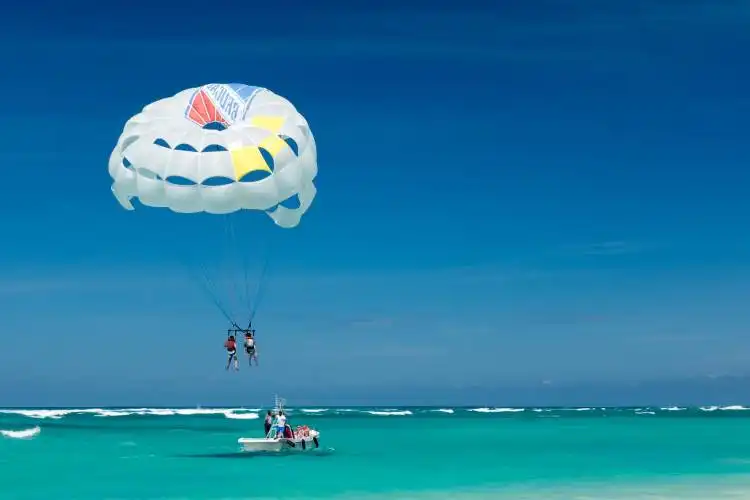Start an Outdoor Adventure Business
Becoming One with Nature: Your Guide to Launching an Outdoor Adventure Business
| Updated


OUTDOOR ADVENTURE BUSINESS
Unleash your inner Bear Grylls and dive headfirst into the thrilling world of an Outdoor Adventure Business! This adrenalin pumping venture lets you harness the wild's allure, curating experiences like mountain trekking, river rafting, camping, or zipline excursions for true thrill-seekers. Not only does this business combine 'store-bought' adventure and natural awe, but it also makes the world your office. Trade in your cubicle for the great outdoors and let Mother Nature become your business partner.
Jump to Business Plan
RELATED BUSINESS IDEAS
Browse ALL Hospitality & Leisure Ventures Business Ideas
Discover Your Perfect Domain
Unlock the door to your online success with our hand-picked selection of premium domain names. Whether you're starting a new venture or rebranding an existing one, the right domain can set the tone for your digital presence. Browse through our curated list, each with its unique potential to enhance your brand's visibility and credibility.
OUTDOOR ADVENTURE MINI BUSINESS PLAN
This a quick reality check to help you identify the strengths and weaknesses of your business concept before you dive in.
Business Idea: Outdoor Adventure Business
Expected Percent Margin:
- Gross Margin: 30-40%
- Net Profit Margin: 10-20%
Earnings Expectations:
- Daily Earnings: $100 - $400
- Weekly Earnings: $700 - $2,800
- Monthly Earnings: $3,000 - $12,000
- Annual Earnings: $36,000 - $144,000
Earnings can dramatically increase during peak tourist seasons.
Actions to Hit Those Numbers:
Equipment Management:
- Initial Investment: $10,000 to $30,000 for safe and reliable equipment
- Maintenance: Regular equipment checks and maintenance to ensure longevity and safety.
Marketing & Customer Acquisition:
- Web Presence: Effective website with SEO and location-based services to attract tourists.
- Social Media: Engaging content relevant to the adventure sports sector.
- Partnerships: Collaborate with tourism boards, local hotels, and travel agencies.
Staffing & Training:
- Qualified Staff: Hire trained professionals with qualifications in outdoor and adventure sports.
- Staff Training: Regular skills upgrade and safety training sessions.
Insurance and Licenses:
- Insurance: Comprehensive business insurance to cover all activities.
- Permits and Licences: Ensure you have the necessary permits and licenses to operate legally.
Location & Seasons:
- Prime Location: A location where tourist flow is high.
- Seasonal Strategy: Offer a variety of activities fit for different weather conditions.
This is a generalized approximation, the exact numbers could significantly vary based on your location, type of adventure activities, and market competition. It is always wise to consult with a business advisor or conduct a detailed market study before you start.
NOT WHAT YOU HAD IN MIND? Here are more ideas



Browse ALL Hospitality & Leisure Ventures Business Ideas
Grab Your Business Website Name
Before you get caught up in the whirlwind of setting up your business, invest in a domain name. It's a small but significant step that lays the foundation for your brand and makes it easier for customers to find and trust you. Just like you wouldn't build a house without securing the land first, don't build a business without securing your domain name.
"Why? Can't that wait?" Here's why it shouldn't
Step 1: Determine if the Business is the Right Endeavor
Breakdown of Startup Expenses
Starting an outdoor adventure business can be expensive. Before getting started, it is important to do an analysis of the startup costs associated with the business. These costs can include the cost of equipment, insurance, permits, and any other necessary items. It is also important to consider the cost of marketing and advertising, as well as the cost of any staff that may be needed. Additionally, it is important to consider the cost of any licenses or certifications that may be required.
Breakdown of Ongoing Expenses
Once the business is up and running, there are ongoing expenses that must be taken into consideration. These expenses can include the cost of supplies, maintenance of equipment, and any other necessary items. Additionally, it is important to consider the cost of marketing and advertising, as well as the cost of any staff that may be needed. It is also important to consider the cost of any licenses or certifications that may be required.
Examples of Ways to Make Money
There are a variety of ways to make money with an outdoor adventure business. These can include offering guided tours, renting out equipment, offering classes, and providing other services. Additionally, it is possible to make money by selling merchandise such as t-shirts, hats, and other items. It is also possible to make money by partnering with other businesses to offer discounts or special promotions. Finally, it is possible to make money by hosting events such as races or competitions.
Step 2: Name the Business
When it comes to naming your outdoor adventure business, you want to make sure it’s something that will stand out and be memorable. You should also make sure the name is easy to spell and pronounce. It’s also important to make sure the name is not already being used by another business. You can do a quick search online to make sure the name you’ve chosen is not already taken. It’s also important to make sure the name is not too long or too complicated. You want to make sure it’s something that will be easy to remember.
You should also consider the type of business you’re starting and the type of customers you’re targeting. For example, if you’re starting a business that focuses on extreme sports, you may want to choose a name that reflects that. You could also consider using words that evoke a sense of adventure or excitement.
When it comes to choosing a domain name, you should also make sure it’s something that’s easy to remember and type. You should also make sure the domain name is available. You can do a quick search online to make sure the domain name you’ve chosen is not already taken.
Once you’ve chosen a name, you should also consider registering it as a trademark. This will protect your business name and ensure that no one else can use it. You can do this through the United States Patent and Trademark Office.
Finally, once you’ve chosen a name and registered it, you should also consider creating a logo for your business. This will help to create a visual identity for your business and will help to make it more memorable. You can create a logo yourself or hire a professional designer to create one for you.
Step 3: Develop a Business Plan
The business plan should include an executive summary, a company overview, a market analysis, an organizational structure, a product and service offering, a marketing plan, an operational plan, a financial plan, and an appendix. The executive summary should provide a brief overview of the business and its goals. The company overview should include information about the company’s mission, vision, and values. The market analysis should include an analysis of the target market and the competitive landscape. The organizational structure should include information about the company’s management team and the roles and responsibilities of each team member. The product and service offering should include a description of the products and services the company will offer. The marketing plan should include a description of the company’s marketing strategy, including the channels and tactics that will be used to reach the target market. The operational plan should include information about the company’s day-to-day operations, including the processes and procedures that will be used to ensure the company’s success. The financial plan should include a detailed breakdown of the company’s financial projections, including projected income, expenses, and cash flow. Finally, the appendix should include any additional information that is relevant to the business plan, such as resumes of key personnel, legal documents, and contracts.
Step 4: Obtain Licenses and Permits
In order to start an outdoor adventure business, you will need to obtain the necessary licenses and permits. Depending on the type of business you are starting, you may need a business license, a health permit, a zoning permit, and a permit to operate in a certain area. It is important to research the specific requirements for your business and obtain the necessary licenses and permits before you begin operations.
How to Obtain Licenses and Permits
In order to obtain the necessary licenses and permits, you will need to contact the local government offices in the area where you plan to operate your business. You will need to provide information about your business, such as the type of business you are starting, the location of the business, and the type of activities you plan to offer. Once you have provided this information, the local government office will be able to provide you with the necessary licenses and permits.
Cost of Licenses and Permits
The cost of licenses and permits will vary depending on the type of business you are starting and the area in which you plan to operate. Generally, the cost of licenses and permits will range from a few hundred dollars to several thousand dollars. It is important to research the cost of licenses and permits in your area before you begin operations.
Benefits of Obtaining Licenses and Permits
Obtaining the necessary licenses and permits is an important step in starting an outdoor adventure business. Having the proper licenses and permits will ensure that your business is operating legally and will help protect you from any potential legal issues. Additionally, having the proper licenses and permits will help to ensure that your business is operating safely and that your customers are protected.
Step 5: Secure Funding
Securing funding is an important step in starting any business, and an outdoor adventure business is no different. There are a variety of sources of funding available to entrepreneurs, including grants, loans, angel investors, and venture capitalists. Grants are a great option for those who are just starting out, as they do not need to be repaid. Loans are another option, but they require repayment with interest. Angel investors and venture capitalists are another option, but they usually require a stake in the business in exchange for their investment.
Create a Business Plan
Creating a business plan is essential for any business, and it is especially important when seeking funding. A business plan should include a detailed description of the business, a market analysis, a financial plan, and a marketing plan. It should also include a list of startup costs and ongoing expenses. A business plan should be comprehensive and well-researched, as it will be used to convince potential investors to fund the business.
Apply for Funding
Once the business plan is complete, it is time to apply for funding. This can be done through grants, loans, angel investors, and venture capitalists. It is important to do research on each option and to apply to multiple sources of funding. It is also important to be prepared to answer questions and to provide additional information if requested.
Utilize Other Resources
In addition to applying for funding, entrepreneurs should also look into other resources that can help them get their business off the ground. These resources include mentorship programs, business incubators, and crowdfunding platforms. Mentorship programs can provide entrepreneurs with guidance and advice, while business incubators can provide access to resources and networking opportunities. Crowdfunding platforms can also be a great way to raise money for a business.
Step 6: Establish a Location
When deciding on a location for an outdoor adventure business, there are several factors to consider. First, the location should be easily accessible for customers. It should also be in a safe area with plenty of parking and amenities nearby. Additionally, the location should be in an area that has a variety of outdoor activities that customers can participate in. Finally, the location should be in an area that is conducive to the type of outdoor adventure business being started.
Securing the Location
Once a suitable location has been identified, the next step is to secure the location. This may involve signing a lease or purchasing the property outright. It is important to thoroughly research the area and the property before signing any contracts. Additionally, it is important to ensure that the property meets all local zoning and safety regulations. Finally, it is important to ensure that the property is properly insured in case of any accidents or damages.
Step 7: Market the Business
Once the business is up and running, it is important to market it in order to reach the target audience. There are a variety of ways to market an outdoor adventure business. One way is to create a website or blog that showcases the services offered. This should include photos and videos of the activities that are available. Additionally, social media is a great way to reach potential customers. Creating a Facebook page and Twitter account can help to spread the word about the business. It is also important to network with other outdoor adventure businesses in the area. This can help to create partnerships and referrals.
Advertising
Advertising is another way to reach potential customers. This can include print ads in local newspapers and magazines, as well as radio and television ads. Additionally, flyers and posters can be placed in local businesses and outdoor areas. It is also important to consider online advertising, such as Google Ads or Facebook Ads. These can be targeted to specific audiences and can be very effective in reaching the right people.
Promotions
Promotions are a great way to get people excited about the business. This can include discounts or special offers for first-time customers. Additionally, offering free or discounted services to local schools or community organizations can be a great way to get the word out about the business.
Word of Mouth
Finally, word of mouth is one of the most effective ways to market an outdoor adventure business. Encouraging customers to share their experiences with friends and family can be a great way to spread the word about the business. Additionally, offering incentives for referrals can be a great way to get people talking about the business.
Step 8: Hire Employees
When hiring employees for your outdoor adventure business, it is important to take your time and find the right people for the job. Start by creating a job description that outlines the qualifications, duties, and expectations of the position. You should also consider the type of personality that would be best suited for the job. For example, if you are hiring a guide for your outdoor adventure business, you should look for someone who is outgoing and friendly, as well as knowledgeable about the outdoors.
Finding Employees
Once you have a job description, you can start looking for potential employees. You can post the job description on job boards, such as Indeed or Monster, or you can reach out to local colleges and universities to find students who may be interested in the position. You can also reach out to local outdoor organizations and ask if they know of anyone who may be a good fit for the job.
Interviewing
Once you have a list of potential candidates, you can start the interviewing process. During the interview, make sure to ask questions that will help you determine if the candidate is a good fit for the job. Ask questions about their experience, their knowledge of the outdoors, and their ability to work with others. Also, make sure to ask questions that will help you determine if the candidate is reliable and trustworthy.
Training
Once you have hired the right employees, you should provide them with the necessary training. This should include safety training, as well as training on the equipment they will be using and the activities they will be leading. You should also provide them with an overview of your business and the expectations you have for them. This will ensure that they are well-prepared to provide the best experience possible for your customers.
Step 9: Develop a Safety Plan
When developing a safety plan, it is important to consider the different components that should be included. First, it is important to consider the safety of the customers. This includes making sure that the equipment used is safe and that the activities are properly supervised. Additionally, it is important to consider the safety of the environment. This includes making sure that the activities are not damaging the environment and that the business is taking steps to protect the environment.
Training Employees
It is also important to consider the safety of the employees. This includes making sure that the employees are properly trained in the activities that they will be conducting. This includes providing training on the proper use of the equipment, the safety protocols that should be followed, and any other safety measures that should be taken. Additionally, it is important to provide employees with the necessary safety gear and to ensure that they are aware of the safety protocols that should be followed.
Emergency Procedures
Finally, it is important to develop emergency procedures. This includes having a plan in place for how to respond to any accidents or emergencies that may occur. This includes having a plan for how to contact emergency services, how to provide first aid, and how to evacuate customers if necessary. Additionally, it is important to have a plan in place for how to handle any legal issues that may arise.
EXPLORE MORE CATEGORIES
Browse ALL Business Idea Categories
TAKE THE NEXT STEPS










